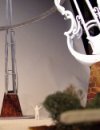
Component
1. The “Video Viewing Rooms”
Each of the “Viewing Rooms” located in the
Visitor Celebration Center has two large wall-mounted flat video screens attached
to opposing walls. The visitor chooses from a push button menu a
selection of short, five to fifteen minute, educational videos depicting
various topics of interest unique to Appalachian Kentucky. Topics would
include, “Wildflowers of the Cumberland Plateau,” “Wildlife,” “Elk,”
“Music of Eastern Kentucky,” “History of Coal,” etc. Regional college
and high school technology classes would produce the videos.
Professionally produced videos from Kentucky Educational Television and
from other sources would also be considered.
The purpose of the “Viewing Rooms” is to educate the visitors on
the distinctive natural and historical elements of the region.
The entryway to the rooms are large, inviting, and without doors.
There are comfortable benches available.
The typical visitor would
view only one or two videos. Therefore, they
have another reason for a return visit.
2.
The “Spiral Banding”
The “Spiral Banding” is a necessary structural
element that connects the instruments. It provides rigidity and
structural integrity to the overall sculpture. It is made of two long
stainless steel tubes arranged in a double helix pattern.
We will use the space between the tubes to tell the history of Eastern Kentucky by incorporating artistic icons.

The choice and arrangement of the icons will involve
area high schools, colleges, and history professionals. The general idea
is something like this: the first icon represents the mountains, the
second a bison, then an arrow head to represent the first indigenous
people, a Daniel Boone figure, a Kentucky long rifle, a Conestoga wagon,
an ear of corn, a coal pick, and so on.
The visitors,
and especially school age children, would learn the
history of the region by discussing the icons. A book with close-up
pictures of each icon along with its historical significance will be
available in the gift shop.
This concept of a visual history
lesson would be greatly
appreciated by school teachers across the state.
3. The “Tourist Information Center”
The “Tourist Information Center,” located in the
Visitor / Celebration Center, educates the visitor to all the tourist attractions
and destinations in the region. This will be done by an innovative use
of standard “Touch Screen Technology.”
Five mid-sized, flat screen
monitors are mounted on the wall. On each screen is a map of
Eastern and Southern Kentucky divided into color-coded corridors
establish by SEKTDA. When a visitor touches a corridor on the main map,
the corridor expands and the counties in the corridor become larger.
Next, touch a county and that particular county expands to show all the
available destinations and attractions. Touch a destination and a
short video appears describing the attraction. This is true for all
attractions across the region.
A short video of, say Cumberland Falls, would be a
highly effective educational and advertising tool. This innovative use
of “Touch Screen Technology” is a marketing tool for the entire region.
This technology will also
be available on the web. (Hey Marketing folks, this is big, really big.)
4. The “Monument Signature Display Area”
The “Monument Signature Display Area” will
use similar “Touch Screen Technology” as described above but it will
link each signature found on the viewing platform of the monument with a
short video depicting the person demonstrating his or her talent. For
example, touch James Still’s name and a short video appears with Mr.
Still reading a passage from one of his books. Touch the name of a
famous, or not so famous, musician and see them performing one of their
songs.
This will educate visitors to the people of Appalachian Kentucky
who have made an impact on the culture and heritage of the region.
This will also be available on the web.
5.
The Walking Trail
The ADA Compliant Walking Trail will have signs
and markers to identify indigenous trees and plants. There will also be
other educational displays along the route.
6.
Displays and Demonstrations in the Visitor Center
There will be on-going, scheduled educational
displays at the visitor center depicting Appalachian life and culture.
This would include music, pioneer life, crafts, history displays, etc.
7. The Amphitheater
The amphitheater would be used for both concerts and for
educational purposes. The amphitheater would be available for use by
teachers as an outdoor classroom and as a staging area for field-trips.
8.
Regional Collaboration and Cooperation Among Citizens and
Educational Institutions
The Eastern Kentucky Heritage Monument is a
grassroots, citizen driven enterprise. Implementing many of the
educational elements will require input from interested people and
educators from throughout the region. From video production to icon
selection to on-going displays- in fact the entire monument- is an
educational facility for the people of Appalachian Kentucky.
9.
Small indoor Theater
A small theater
located in the Visitor / Celebration
Center will be a venue for educational School Field Trips such as
children's theater and concerts as well as for community concerts and
cultural events.
10. Education to Replace Negative
Stereotypes
The Eastern Kentucky Heritage Monument gives us
the opportunity to showcase the good things about our region. It allows
us to educate people from around the world to the truth about
Appalachian Kentucky. This monument allows us to challenge and repudiate
the false, negative stereotypes that have been forced onto us by
journalists beyond our control. It allows us to re-define our image to
the outside world into one of our own choosing.
